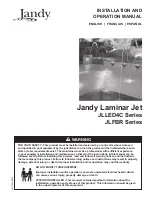
18
MAINTENANCE:
CHLORINE LEVEL CONTROL:
In hot periods, the system requires a longer operating time, since higher water temperature
and increased solar radiation accelerate decomposition of the chlorine generated. The water's
chlorine requirement also increases when bathers are more frequently using the pool
(higher level of organic material). To ensure chlorine production is correct, regularly check
the chlorine level. If the reading is low (<0.750 ppm), increase the system's production
level with the (+) button or connect the filtration for more hours per day. If the reading is
low (>1.75 ppm), reduce the system's production level with the (-) button or reduce the
filtration operating time.
It is recommended to distribute the saline electrolysis system's operating time to operate
during the day and the night. If the correct levels of chlorine are not detected in the water after
a period of normal operation, check that the system is producing chlorine by performing the
following measurements.
1. Check that the filtration and the MAMNET ECO system are connected and operating.
2. With an analysis test kit, take a sample of water as close as possible to the swimming pool's
driving nozzles. To take the sample, place the thumb over the end of the test tube and
place it just in front of the nozzle to ensure the water sample taken comes directly from
the nozzle (X).
3. Now take a reading of the total and free chlorine levels.
4. Take another water sample as far away as possible from the nozzles, and measure the
total and free chlorine levels again (Y).
5. Compare the measurements. If reading "X" is much higher than “Y” and the system is well
dimensioned in terms of the swimming pool capacity and its level of use, it is possibly
producing chlorine instability. To avoid this, add 45 gr/m3 of cyanuric acid. Instability
(disappearance of active chlorine in the water) occurs naturally due to exposure to the
sun and high water temperature.
6. If the combined chlorine is much higher than the free, its disappearance is due to the
reaction with organic material.
Summary of Contents for MAMNET ECO 15
Page 1: ...MANUAL MAMNET ECO 15 20 30 45 ...
Page 22: ...21 Max submergible limit ...
Page 24: ...23 ...
Page 26: ...25 ...
Page 29: ...28 NOTES ...
Page 30: ...29 ...
Page 31: ...30 ...
Page 32: ...31 ...














































